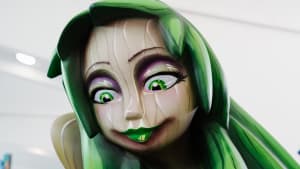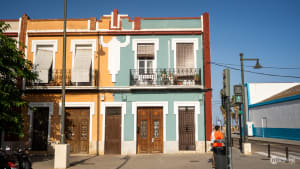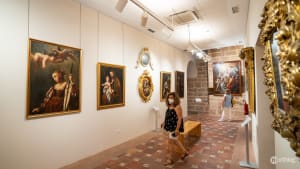
Valencia for Art Lovers
From contemporary art museums to exhibition centres and workshops, to centuries-old churches, Valencia is brimming with all kinds of artistic expressions.
Valencia for art lovers in a nutshell...
Valencia’s artistic heritage spans centuries and styles across the city.
Religious masterpieces can be admired in San Nicolás Church (nicknamed “Spain’s Sistine Chapel”) with its breathtaking ceiling frescoes and Valencia Cathedral housing the Holy Grail, while the Museu de Belles Arts displays Spain’s second-largest collection of fine art featuring works by Goya, Velázquez, and El Greco.
Contemporary expression thrives at the IVAM (Valencian Institute of Modern Art), the experimental Centre del Carme housed in a 13th-century monastery, and the futuristic Palacio de las Artes Reina Sofía.
Beyond formal institutions, art permeates the streets with vibrant graffiti in the El Carmen neighborhood and independent galleries and artist workshops in the trendy Ruzafa neighborhood.
Valencia is a lucky place for all art lovers. The city doesn’t only have the classic art museums and old churches (although there are plenty of those too), but it also offers a multitude of contemporary cultural and art centres, with all kinds of exhibitions and new pieces coming in every few months or even weeks.
The streets are not to be overlooked either, as graffiti and small art workshops can be found all over the city’s most popular neighbourhoods. Here we have gathered ten essential destinations in Valencia for all art aficionados.
Iglesia de San Nicolás
The Iglesia de San Nicolás de Bari y San Pedro Mártir, also simply known as Saint Nicholas Church, is the second most visited religious building in Valencia. Its fame is not only due to its unique combination of Gothic and Baroque styles but also to its spectacular ceiling frescoes.
Even the non-religious types can’t help but be completely captured by this feature, which has earned the church its nickname Sistine Chapel of Spain.

The lives of the two saints that give their names to the church - Saint Nicholas and Saint Peter Martyr are told through the paintings on the church’s ceiling and lunettes. Some of the stories are exactly what you would expect from a saint - healing, preaching, etc. Others, instead, are extremely gruesome and grotesque. See if you can find the plate of (human!) meat on your visit to the church.
Instituto Valenciano de Arte Moderno
The Instituto Valenciano de Arte Moderno (IVAM) is a modern and contemporary art museum in Valencia’s Carmen neighborhood. It has a permanent collection of about 12,000 works by both Spanish and international artists, but the majority of the rooms host temporary exhibitions, conferences and artistic events.

In a sense, when you visit, you’re seeing something that is never going to be the same again. Here, you can learn and reflect on the ideas that have shaped and continue to shape artistic discourses.
The museum is always presenting unexpected and challenging ideas in a fascinating way. Museum personnel are present in every room and are always happy to clarify the concepts behind the exhibitions in an understandable and, most importantly, compelling way (and this we can tell you from personal experience).
Casa-Museo José Benlliure
This studio house turned museum will immerse you in the life and works of local painter José Benlliure. You will walk into a permanent exhibition centre, displaying not only the works of the artist but also his home and workshop.

The Casa-Museo José Benlliure offers a unique portrait of turn-of-the-century Valencia and how wealthy families in the city lived at the time. The interior is filled with paintings, art material, as well as period furniture and decor. It is located at the northern edge of the Carme neighbourhood.
Street Art in El Carmen
While many cultural centres in the city display valuable and elaborate pieces, Valencia is a place where art is in the streets too. You will find beautiful graffiti all around the city, but the highest concentration is in El Carmen. Here, you can find amazing works of art that create unusual sights.

The striking colours stand in contrast with their canvases: the side of an old and crumbled building, the low and unassuming brick enclosures among narrow streets, or the large walls next to important sights and squares.
The temporary nature of this art form means that the murals are often replaced by the very active street art community, transforming the neighbourhood overnight. Locals appreciate the contribution that the pieces make to the city, commenting on society, politics, and local culture. This allows for the artists to work mostly undisturbed, even though graffiti is not officially permitted.
Centre del Carme Cultura Contemporània
Centre del Carme (also known as CCCC) is a contemporary culture centre that hosts a wide range of intersectional artistic practices representative of current culture.

Among these, you will find visual arts, experimental and performing arts, sound art and design, as well as other branches of thought such as sociology, architecture, urban planning, and medicine.
The centre occupies part of what used to be a 13th-century monastery, the Real Monasterio de Nuestra Señora del Carmen, in the Carme neighbourhood.
Museu de Belles Arts
The Museu de Belles Arts (Museum of Fine Arts), which houses about 2,000 works, is the second largest art gallery in all of Spain. It mainly comprises works from the 14th to the 17th century.

Both Valencian and Spanish artists such as Vicente López, Juan de Joanes, Goya, Los Ribalta, Velázquez, Pinazo, Joaquín Sorolla, Murillo, and Benlliure are featured. As for the international ones, El Greco, Van Dyck, Pinturicchio, Piranesi and del Sarto are present as well.
Aside from this plethora of Renaissance, Baroque, Neoclassical, Romantic, and Impressionist paintings, the Museum’s collection also includes older pieces, among which archaeological remains, a Palaeo-Christian tomb, and a number of Gothic panels. Displayed you’ll also find drawings, etchings, sculptures, architectonic fragments, portable art, and even contemporary pieces.
Exposició del Ninot and Museu Faller
In March the city of Valencia hosts the Fallas festival, in which each neighbourhood produces a wood and papier-mâché sculptural scene known as falla. The fallas are burnt at the end of the festival on 19th March, for the Cremà. However, some of their components are saved.

The Exposició del Ninot, held between the end of February and the 14th of March, gathers hundreds of figures built by the Fallas artists. These figures, called ninots, are normally part of different fallas. The aim of the exhibition is to choose which ones will be spared from the final bonfire. As a matter of fact, if you go, you’ll get to choose the ninot you would like to see pardoned.
But if you’re not in Valencia during this time, you can always get to see the pardoned ninots, which are kept in the Museu Faller. This museum is, by the way, the only one in the world where pieces are incorporated by popular vote. Inside, you will find a huge collection of ninots, the oldest of which date back to 1934.
Catedral de Valencia and Miguelete
The Cathedral of Valencia (also called la Seu) is Valencia’s most important religious building and the place where the Holy Grail is kept, according to the Roman Catholic Church. In typical Valencian fashion, the church was built on an ancient mosque and remodelled several times, still retaining various elements in different styles, mainly Gothic, Baroque, Romanesque, and Neoclassical.

If all the artwork above the ground wasn’t enough, the Cathedral also has an incredible underground museum with magnificent and precious artefacts and relics. Original paintings, sculptures, shrines, illustrated manuscripts and sacred items (like the Processional Monstrance of the city) can all be admired inside the Museum.
Palacio de las Artes Reina Sofía
The Palacio de las Artes Reina Sofía (Queen Sofia Palace of the Arts) is an arts centre dedicated to music and the scenic arts. The building, located in Valencia’s City of Arts and Sciences complex, acts as an opera house and has hosted many cultural events such as dance performances, theatre and music in its auditoriums.

The Palau de les Arts is equipped with large stages and the latest technology, which helps bring to life all sorts of opera, plays, musical and dance performances. From a visual standpoint, the centre is possibly the most enigmatic building in the City of Arts.
This magnificent structure is surrounded by more than thousands of square feet of landscape and water, and it is encased in two laminated steel shells. What resembles a floating feather covers the top of the building. Its interior platforms are interconnected through stairways and panoramic lifts.
Art Workshops in Ruzafa
The Rusafa neighbourhood is known for its independent art galleries and small art workshops. In this barrio you are sure to find all kinds of art spaces, from art gallery cafès, to open spaces where jazz musicians perform live, to upcycling art galleries.

One of the most well-known workshops is the Sporting Club, a coworking space for almost a dozen artists. There, you’ll see the exploration of various art forms, including sculpture, painting, performance and scenic arts, architecture, and photography. At these kinds of galleries, you can enjoy the exhibitions as well as buy directly from the resident artists.
Palau de la Música
The Palau de la Música is one of the most important concert and exhibition halls in Europe, as well as a cinema and arts centre. The city’s municipal orchestra, the Orchestra of Valencia, is based here. The building is located in the Túria Park’s 11th tramo (section).

The Palau’s shining glass dome, framed by peaceful palm trees, seems to rise directly from the surrounding lake waters. The transparency of the glass and water, coupled with the green of the plants, is the aesthetic thread that runs through the halls of this building.



















